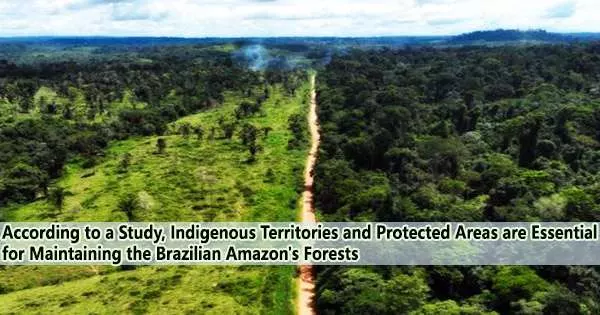Time series satellite images from 2000 to 2021 were analyzed in a study led by researchers with the Center for Earth Observation and Modeling at the University of Oklahoma. The results showed the critical importance of Indigenous territories and protected areas in Brazilian Amazon forest conservation.
The study’s findings, which were recently published in Nature Sustainability, highlighted the detrimental effects of the government’s newly weakened conservation laws. The Brazilian Amazon is home to the world’s largest tropical forest and richest biodiversity.
Since 2000, Indigenous territories and protected areas have increased substantially in the region, and by 2013; Indigenous territories and protected areas accounted for 43% of the total land area and covered approximately 50% of the total forest area.
Yet, conflicts still exist between objectives for socioeconomic development and forest protection. In Brazil, significant socio-ecological changes have recently put the preservation of forests in jeopardy. Indigenous tribes in the area were severely harmed by lax forest and environmental laws and regulations, the COVID-19 pandemic, and other factors.
In this U.S.-Brazil collaborative study, Yuanwei Qin, Ph.D., and Xiangming Xiao, Ph.D., of OU’s Center for Earth Observation and Modeling, with Fabio de Sa e Silva, Ph.D., assistant professor of international studies and Wick Cary Professor of Brazilian Studies in the OU College of International Studies, worked with collaborators from the Brazilian National Institute for Space Research and the National Institute for Research in Amazonia in Brazil.
Between 2000 and 2021, the areas designated as Indigenous territories or protected areas increased to cover approximately 52% of forests in the Brazilian Amazon, accounting for only 5% of net forest loss and 12% of gross forest loss in the period. This finding highlights the vital role of Indigenous territories and the protected areas for forest conservation in the region.
Yuanwei Qin
The research team integrated many data sources to analyze the dynamics and effects of forest loss during the past 20 years in the Brazilian Amazon. Annual forest maps created from optical image analyses of the Brazilian Amazon have only fair accuracy due to the region’s frequent cloud cover and smoke from fires.
In a 2019 study that was published in the same journal, the research team created annual maps of the Brazilian Amazon jungle using picture data from optical and microwave sensors. They evaluated the impact of Indigenous territories and protected areas on the dynamics of deforestation in the Brazilian Amazon until 2021 using these annual forest maps.
“Between 2000 and 2021, the areas designated as Indigenous territories or protected areas increased to cover approximately 52% of forests in the Brazilian Amazon, accounting for only 5% of net forest loss and 12% of gross forest loss in the period,” said Qin. “This finding highlights the vital role of Indigenous territories and the protected areas for forest conservation in the region.”
The Brazilian Amazon’s protected areas are managed according to various state and national governance structures, with varying management goals, such as stringent protection or sustainable usage. They discovered that between 2003 and 2021, gross forest loss decreased by 48% in protected areas with rigorous protection and by 11% in protected areas with sustainable usage.
“These varying effects on forest conservation call for more in-depth causal analyses by researchers and invite stakeholders, decision-makers, and the public to reassess existing policies for these areas. Legal designations are important, but if the law is not enforced, the intended protection of forests and biodiversity will be illusional. This is an area in which Brazil is knowingly failing,” de Sa e Silva said.
The results from this study also show that annual forest area loss was affected by Brazilian forest policies, as evidenced by a large reduction of forest area loss in the early 2000s to mid-2010s, corresponding with Brazilian President Luiz Inácio Lula da Silva administration in 2003-2010, and renewed rise of forest area loss even among Indigenous territories and the protected areas in 2019-2021, corresponding with President Jair Bolsonaro’s administration in 2019-2022.
“How to rebuild effective policies and reduce forest area loss in the Brazilian Amazon in the coming years will be one of the grand challenges for Lula’s administration and international communities,” Xiao said.
This study adds to a portfolio of research efforts to document forest areas in the Brazilian Amazon by Qin and Xiao, including a 2019 paper, “Improved estimates of forest cover and loss in the Brazilian Amazon in 2000-2017,” published in Nature Sustainability; a 2021 paper, “Carbon loss from forest degradation exceeds that from deforestation in the Brazilian Amazon,” published in Nature Climate Change; as well as two others.





